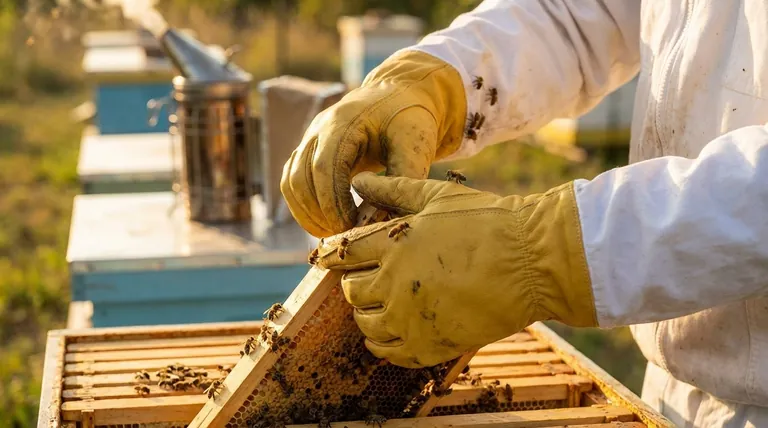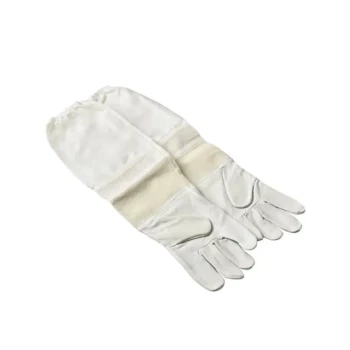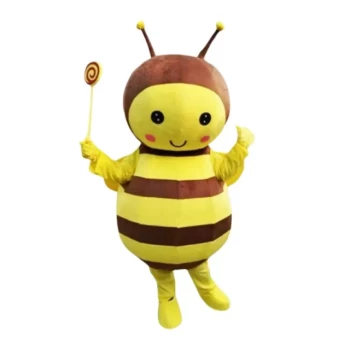The right beekeeping glove fit is not just about comfort; it's about control. A snug fit is crucial because it directly impacts your dexterity, the safety of your bees, and the effectiveness of your protection. Loose, bulky gloves can lead to clumsy movements, while a proper fit allows you to work with precision and confidence.
Your choice of glove fit represents a critical balance between protection from stings and the dexterity needed to be a good steward of your hive. A snug fit optimizes for both, preventing accidental harm to bees while ensuring your own safety.

The Core Functions of a Snug Fit
A properly fitting glove is an active tool, not just a passive barrier. Its importance can be understood through three primary functions.
Enhancing Dexterity and Control
A key part of beekeeping is handling delicate items, from individual frames to the queen bee herself.
Excess material in a loose glove bunches up, reducing your tactile sensitivity and fine motor skills. A snug fit restores your ability to feel and manipulate hive components with precision.
Protecting Your Bees
Your primary goal during an inspection is to assess the hive with minimal disruption.
Loose-fitting gloves dramatically increase the risk of accidentally crushing bees when you grip a frame or move boxes. The excess material can trap and kill bees, which is detrimental to the colony's health and morale.
Ensuring a Secure Sting Barrier
While the material of the glove provides the main protection, the fit ensures there are no points of entry.
Bees can and will crawl into any available opening. A glove that is snug at the wrist creates a seal with your beesuit, preventing bees from getting inside and stinging your wrists or arms.
Understanding the Trade-offs and Risks
Choosing a glove is not a one-size-fits-all decision. You must weigh the need for protection against the need for sensation.
The Risk of a Loose Fit
The most significant risk of a loose fit is a loss of control. This clumsiness can cause you to drop a frame full of brood or accidentally roll and kill your queen.
This lack of control not only endangers the bees but can also trigger a defensive reaction from the colony, leading to more stings.
The Problem with a "Too Tight" Fit
"Snug" does not mean tight. A glove that is too tight will restrict blood circulation, cause hand fatigue, and make your movements stiff.
Furthermore, a tight fit can stretch the material, potentially making it thinner and more vulnerable to a bee's stinger.
The Middle Ground: Nitrile Gloves
Some experienced beekeepers argue that even the best leather gloves reduce their "feel" for the hive.
For tasks requiring maximum dexterity, some will use thick nitrile gloves. These offer a compromise, providing a barrier against honey and propolis with more sensation, but they offer significantly less protection from stings than traditional leather.
Making the Right Choice for Your Goal
Your ideal glove depends on your experience level and the specific task at hand.
- If your primary focus is maximum protection: Choose a well-fitting, thick leather glove (like goatskin) with a long cuff to build confidence and minimize stings.
- If your primary focus is dexterity for delicate tasks: Consider using a high-quality, thick nitrile glove for that specific task, understanding the increased risk of stings.
- If your primary focus is hive health: Always prioritize a snug fit to prevent accidentally crushing bees between your fingers or on frames, regardless of material.
Ultimately, the best glove is one that allows you to work calmly and confidently, ensuring the safety of both you and your colony.
Summary Table:
| Key Aspect | Why a Snug Fit Matters |
|---|---|
| Dexterity & Control | Enables precise handling of frames and delicate hive components. |
| Bee Safety | Prevents accidental crushing of bees, protecting colony health. |
| Sting Protection | Creates a secure seal at the wrist to block bee entry. |
| Risk of Loose Fit | Leads to clumsy movements, dropped frames, and defensive bee reactions. |
Equip your apiary with confidence. The right glove fit is essential for efficient, safe beekeeping. HONESTBEE supplies professional-grade beekeeping gloves and equipment designed for the needs of commercial apiaries and distributors. Our wholesale-focused operations ensure you get durable, well-fitting gear that protects both you and your bees.
Contact HONESTBEE today to discuss your equipment needs and enhance your hive management.
Visual Guide

Related Products
- Beekeeping Gloves Goatskin Leather with Long Cotton Sleeve for Beekeepers
- Mesh Ventilated 3 Layer Goatskin Beekeepers Gloves for Beekeeping
- Goatskin Leather Beekeeper Gloves with Vent Long Sleeve for Beekeeping Honey Bee Sting Proof Protection
- Goat Skin Leather Bee Sting Proof Beekeeping Gloves with Canvas Sleeve
- Professional Drop-Style Hive Handles for Beekeeping
People Also Ask
- What are the arguments for and against using gloves in beekeeping? Balancing Protection and Dexterity
- What should beekeepers consider regarding the fit of beekeeping gloves? Achieve Safety and Dexterity
- What is the safest way to handle frames in beekeeping? Master Gentle Handling for a Calm Hive
- Why do some experienced beekeepers choose not to wear gloves? For Superior Dexterity & Hive Welfare
- Why are protective gloves important in beekeeping? Boost Confidence & Safety in Your Apiary



















